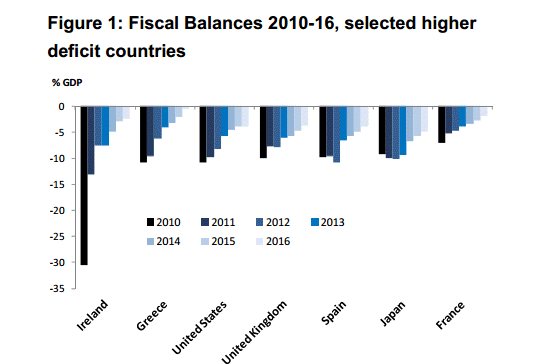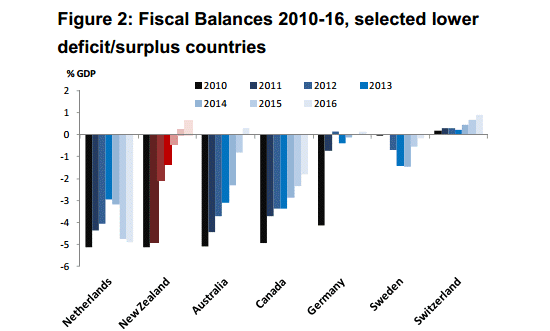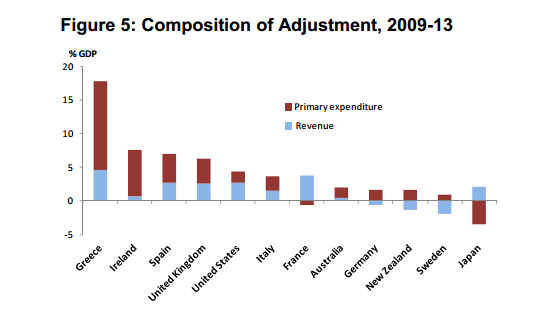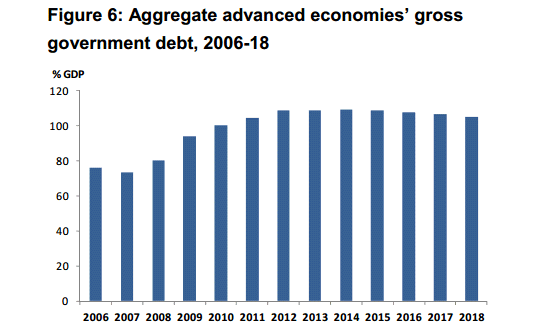
This content is taken directly from the Special Topic section of the Treasury's monthly economic indicators for October 2013.
------------------------------------------------------------
Many advanced economies emerged from the global financial crisis with high government debt and large fiscal deficits.
In response, most of these countries are undertaking fiscal adjustments to reduce deficits, and stabilise and ultimately reduce government debt.
Drawing on recent data from the International Monetary Fund (IMF) (particularly the October 2013 Fiscal Monitor ), this note addresses the international fiscal consolidation experience so far and how New Zealand compares.
Fiscal consolidation in advanced economies is proceeding
Many advanced economies have made significant efforts over recent years towards fiscal consolidation.
Deficits in most countries have narrowed since 2010 and are forecast to continue to narrow (Figures 1 and 2 – note differences in scale).


2013 is expected to be a year of particular progress compared with previous years (although individual country plans differ).
Consolidation in 2014 and beyond is expected to be more moderate, reflecting the progress made thus far.
Similarly, government debt is expected to stabilise and then start to decline in most countries, although in the near term debt continues to rise for some.
Figures 3 and 4 show the government debt paths from 2010 to 2016 in selected countries (again, note differences in scale).


However, although fiscal consolidation is proceeding broadly as planned in most countries and deficits are narrowing, the extent of actual reduction in deficits so far is not as significant as originally anticipated.
The main reason for this is that most countries have experienced weaker economic growth than expected, leading to weaker revenue.
Different countries have approached consolidation differently
The trends of narrowing deficits and stabilising then declining government debt broadly reflect the experience of most advanced economies.
But underneath these trends are a number of different approaches. One difference between countries is the extent to which consolidation is achieved by spending measures, revenue measures, or both. New Zealand is somewhat unusual (although not totally alone) in that its fiscal consolidation has been largely on the spending side.
Figure 5 shows the extent to which fiscal consolidation so far has been by spending or revenue measures, or both, across a sample of countries (a positive value represents fiscal consolidation and a negative value represents fiscal expansion).

As Figure 5 shows, many countries have relied on both revenue and spending initiatives to help reduce their deficits. In many cases, the share of consolidation on the revenue side was more than was initially planned.
There are differences in approach beyond the mix of spending and revenue initiatives.
The United States, the United Kingdom, France and Greece are proceeding with fiscal consolidation at a faster pace than most other countries, with adjustment likely to be more than 1% of GDP in 2013.
To a large extent this comparatively faster adjustment reflects different starting points, as most of the countries on fast consolidation paths had comparatively high deficits to begin with.
Still, individual country circumstances are relevant too. For example, much of the consolidation in the United States in 2013 is due to the extension of automatic spending cuts, or the “sequester”.
At the other end of the spectrum, some countries that do not feel such immediate pressure to consolidate are actually loosening fiscal policy slightly in 2013.
Sweden, Germany and Canada fall into this category. In some cases this reflects the fact that these countries have not faced the need for significant adjustment – Sweden is an example. In Germany, on the other hand, fiscal easing reflects the fact that deficit goals were achieved ahead of schedule.
In the middle, countries such as Ireland and Spain are continuing with fiscal consolidation into 2013 and beyond, but at a more moderate pace than the fast consolidation group.
Japan is unusual in that fiscal consolidation is yet to get underway despite having a large deficit and high government debt (it is one of the few countries surveyed that actually increased its deficit since 2010). Consolidation is planned for 2014 and beyond, although some details of what that will involve have yet to be fleshed out.
Getting debt back to acceptable levels is still a challenge for most countries...
Even assuming that planned fiscal consolidation takes place, many countries will still have levels of government debt at or near historical peaks, leaving them vulnerable to economic shocks.
Accordingly, the IMF advises most advanced economies to continue efforts to reduce government debt throughout the 2020s.

... but New Zealand is relatively well-placed
Compared with many advanced economies, New Zealand is well-placed in terms of moving into surplus and being able to start reducing its debt.
Under current forecasts, New Zealand will move into surplus in the 2014/15 fiscal year (or the 2015 calendar year under the IMF forecasts, which are prepared on a calendar year basis).
Of the advanced economies that the IMF surveys, only Estonia, Hong Kong, Korea, Norway, Singapore and Switzerland will also achieve surpluses in 2015.
Moving into surplus means that New Zealand can start paying down its government debt sooner than many other countries.
Also, New Zealand’s starting position is more favourable in that government debt was at historically low levels in 2008. Despite two shocks – the global financial crisis and the Canterbury earthquakes – New Zealand’s government debt did not rise to the levels seen in other advanced economies.
The Annual Financial Statements of the New Zealand Government, released on 7 October 2013, show New Zealand is in an even stronger position than that reflected in the IMF’s analysis.
The IMF data for New Zealand is based on Budget 2013 forecasts, so values for 2013 are forecasts rather than actual data.
But in fact, actual results for the 2012/13 fiscal year were stronger than forecast at Budget 2013. In particular, the 2013 Financial Statements show New Zealand’s operating balance to be -2.1% of GDP in 2012/13, as opposed to the forecast at Budget 2013 of -2.9% of GDP.
Similarly, net core Crown debt was forecast to be 27.1% of GDP in 2012/13, but was in fact 26.3% of GDP.
5 Comments
If government is willing to guarantee the banks - some not ours, shouldn't some recognition of this liability (often cropping up just when things are looking grim) be made (other unfunded liabilities aside)...
There also seems a case to be made that ratios may a little light on (GDP bigger than, really)..
For example, as credit growth drives part GDP, credit growth provided for asset purchases at a market value greater than investment value hollows the log (inflates GDP, attaching a servicing liability taking income (tax and earnings) out of the loop).
We also like to look at these big picture numbers on a per capita basis, as it looks like wages are not reflecting the happiness...
And brings the chestnut question: If things have never been better (free tradeeement, payout, export receipts...), where is the loot? i.e. retained profits, savings, tax receipts and pools of investment capital here.?
Does this tell us anything policy-wise... how to encourage activity that results in retained profits to be held here. Hint do not use capital gains tax as part of your answer...
- weren't things better (comparatively) is the late 1960's, early 1970's - back when households could function/operate/be happy on one income....? and count the number of unemployed on one hand...
GDP is not a very good measure of the really important details - yet there is an obsession by Politicians and bureaucrats to use it as the yardstick.
Where is the loot? Repatriated to its Alien investors............
NZ's taxation apartheid system is what is affecting the households ability to function/be happy on one income..........
Allowing assets to be sold into Alien Investors ownership and giving these Alien investors large tax advantages over the NZ nationals will have significant consequences.
The government would be better to focus on increasing the tax take through economic growth than taking the defensive route of debt reduction. Public debt in this country is already low enough. The irony is that our public debt is amongst the lowest in the world and yet we pay among the highest interest rates. Goes against convential wisdom.
If your keep allowing Alien investment into NZ productive assets and don't capture the income tax due to the tax treaties then you are asking all NZ nationals to work with less and less. The only option that I can see is to put the GST rates up and reduce the income tax rates further. However this would hurt lower and middle level incomes the most.
If your keep allowing Alien investment into NZ productive assets and don't capture the income tax due to the tax treaties then you are asking all NZ nationals to work with less and less.
And let's not forget thin capitalisation methods demanding excessive interest bearing debt funding sourced from the foreign owner (as you say tax exempt), thus diminishing ex-interest local corporate earnings to non-taxable losses.
We welcome your comments below. If you are not already registered, please register to comment.
Remember we welcome robust, respectful and insightful debate. We don't welcome abusive or defamatory comments and will de-register those repeatedly making such comments. Our current comment policy is here.